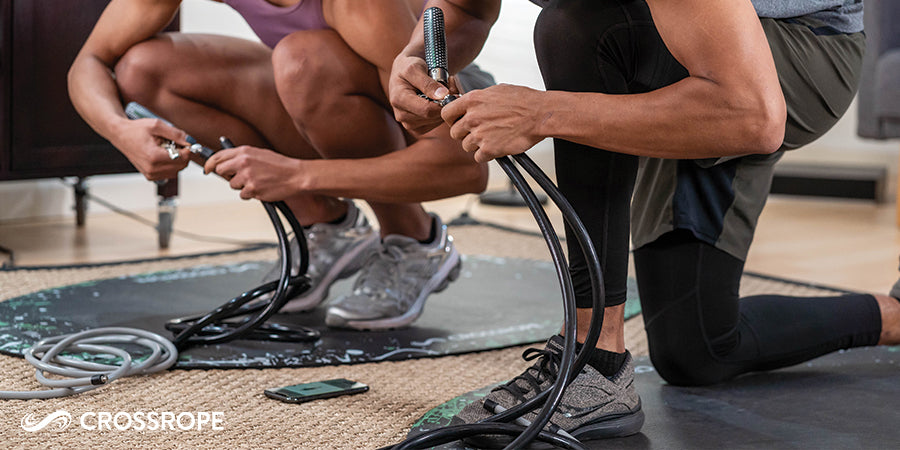One of the most common questions we get at Crossrope is what effects and benefits there are from using heavy (weighted) jump ropes.
Heavy rope training, although quite powerful, is only recently gaining popularity.
Only after a weighted rope workout do people actually start to realize the immense benefits. And with that realization come interesting questions.
What's the benefit of using heavy rope?
Is there a difference between weighted ropes and weighted handles?
What design elements make a heavy jump rope effective?
We address all of these questions in this week's post. Let's dig in.
Benefits of Heavy Jump Rope Training
We've talked about the benefits of weighted jump rope training in the past and we even have a quick video to help you better understand.
But here's a quick snapshot of the benefits of heavy jump rope training:
- Progressive resistance and more advanced training options
- Improved feedback and slower rotation (important for beginners)
- Upper body power + shoulder development
- Overall greater muscle engagement (see photo below)
- Easier to maintain a good arc (important for beginners)
- More training versatility

The heavier the jump rope, the greater the resistance, and the more impressive the results.
The Importance of Design
So what about the design?
How does the design of the (heavy) jump rope affect your ability to you achieve all the jump rope benefits we've discussed above.
Let's look at three important design principles.
Design Principle #1 - Weight Placement
What is the difference between having the weight in the rope vs. having the weight in the handle. This is a question we get a lot.
Here's the deal...
The problem with having the weight in the handles is two-fold:
1) Since you're holding the handle in place at all times, the weight does not move very fast or very far so your body doesn’t need to do much work to move that weight and
2) When the handle is heavier than the rope, it can cause issues with rhythm and feel.
On the other hand, when the weight is distributed throughout the rope, the weight is moving consistently around your body. And the faster it moves, the greater the centrifugal force that's generated and the more your muscles have to work to handle that force.
Here's a quick video we created that covers the simple differences:
The big takeaway: Heavy jump ropes that have the weight in the rope itself provide much more dynamic resistance and give a far better upper body workout.
Design Principle #2 - Rope Design
More specifically, we're referring to the difference between coated wire ropes (like ours) and your typical plastic, rubber, or braided rope designs.
This is something we haven't touched on a lot in the past.
Here are some things to note about plastic and braided ropes -
The good thing with these options is that they're relatively inexpensive. But that typically means sacrifices have been made on the quality side.
Here's the the issue with weighted plastic or rubber ropes - they are prone to issues such as snapping, stretching, and coiling which isn't great from a user experience perspective.
Braided rope designs are thick for their weight, meaning that they are slower to turn and difficult to get a good rhythm going.

So how do coated wire ropes like ours differ?
Coated wire ropes won’t stretch, snap, or tangle. Quality is always the main priority.
The added benefits of focusing on quality mean the ropes maintain a consistent arc at all times and because of the wire inside, they’re more dense and can be rotated more quickly leading to higher resistance and more intense upper body workouts.
Design Principle #3 - Ball Bearing Connection
This is one design aspect that flies under the radar but makes all the difference.
When it comes to weighted jump rope training, the design of the ball bearing connection is quite crucial if you're trying to foster a fun and effective jump rope experience.
Many weighted ropes use a design that has a poor rotating connection, or no connection at all which not only makes it frustrating to turn the rope, but it also encourages poor jumping form, destabilizes and places excessive strain on the wrists and shoulders, and can increase the chance of injury.
Our focus on good ball bearing connection means that your heavy rope will spin smoothly, relieve strain on the wrists and shoulders, and enable faster rotation for powerful full-body training.
What Heavy Rope Should I Start With?
Once people are sold on the benefits and advantages of heavy jump rope training, the next question is always the following:
What jump rope set should I get?
Well, we'd like you to consider Crossrope because we've addressed all of the issues mentioned above with our designs:
1. Weight Placement - The weight of our jump ropes is primarily in the ropes, and not that handles. This ensures you get a challenging upper body workout.
2. Rope Design - Our ropes are PVC coated cable. They don't tangle or coil, they maintain a consistent arc, and they rotate smoothly and quickly.
3. Rotation design - We used the highest quality, ball bearings for smooth jumping, and to protect your wrists and shoulders from excessive torque and strain.
We offer several jump rope combo sets, but when it comes to choosing your first set, the most popular choice for heavy ropes is the Get Fit Bundle:
The Get Fit Bundle comes with four high-quality heavy jump ropes and two pairs of jump rope handles- one slim and one set of power handles. All of these ropes can be used indoor and outdoor.
Click here to get your Get Fit Bundle.
Your Turn
Have you used a heavy rope yet? If so, share your experience in the comments below. If you haven't, let us know what's been holding you back.











